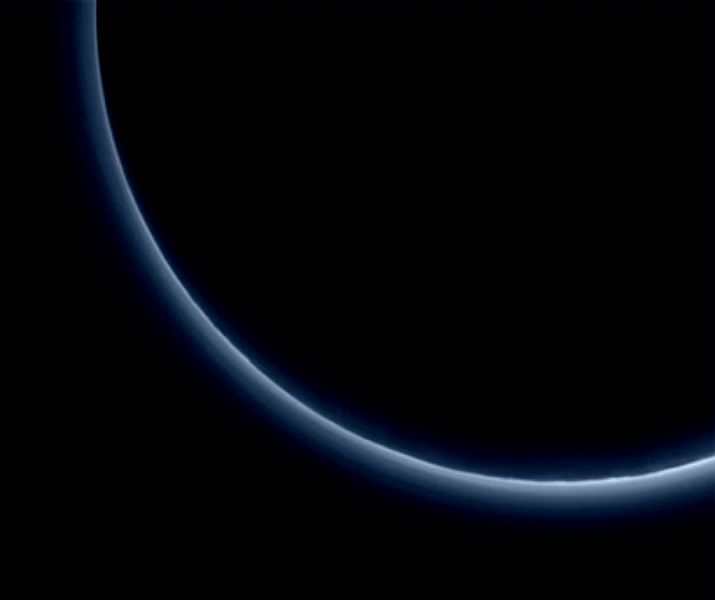File:NH-Pluto-Atmosphere-20150810.jpg

原始檔案 (777 × 652 像素,檔案大小:42 KB,MIME 類型:image/jpeg)
摘要
| 描述NH-Pluto-Atmosphere-20150810.jpg |
English: https://blogs.nasa.gov/pluto/2015/08/10/atmospheric-escape-and-flowing-n2-ice-glaciers-what-resupplies-plutos-nitrogen/
Backlit by the sun, Pluto’s atmosphere rings its silhouette like a luminous halo in this image taken by NASA’s New Horizons spacecraft.
Pluto - New Horizons Atmospheric Escape and Flowing N2 Ice Glaciers – What Resupplies Pluto’s Nitrogen? Posted on August 10, 2015 at 3:26 pm by ptalbert. IMAGE: => http://blogs.nasa.gov/pluto/wp-content/uploads/sites/253/2015/08/nh-pluto-atmosphere-300x252.png Backlit by the sun, Pluto’s atmosphere rings its silhouette like a luminous halo in this image taken by NASA’s New Horizons spacecraft. Hi, I’m Kelsi Singer, a postdoctoral researcher at the Southwest Research Institute, working on NASA’s New Horizons mission and specializing in geology and geophysics. One of my areas of expertise is impact cratering. That subject may not seem related to Pluto’s atmosphere or nitrogen at first, but let me tell you about research that New Horizons principal investigator Alan Stern and I conducted and published as a prediction paper before the flyby of Pluto. New Horizons has returned striking images of both Pluto’s surface and its atmosphere. Pluto’s atmosphere is similar to Earth’s in that it is predominantly composed of nitrogen (N). But Pluto’s atmosphere is ~98% N, while Earth’s is only ~78% N. Pluto’s atmosphere is also considerably thinner than Earth’s with ~10,000 times lower pressure at the surface. IMAGE: => http://blogs.nasa.gov/pluto/wp-content/uploads/sites/253/2015/08/nh-nitrogen-mystery-225x300.jpg Kelsi Singer - SwRI Researcher Kelsi Singer The nitrogen in Pluto’s atmosphere (in the form of N2 gas) is actually flowing away and escaping the planet at an estimated rate of hundreds of tons per hour. We also see what looks like flowing ice on Pluto’s surface in high resolution images made by New Horizons. The water ice (H2O) that we are familiar with on Earth would be completely rigid and stiff at Pluto’s surface temperatures, but ice made out of N2 would be able to flow like a glacier. So where does all of this nitrogen come from? One possibility we tested was that cometary impactors could be delivering the necessary material. We explored several different ways that impacts from comets could bring nitrogen to the surface and atmosphere of Pluto and resupply the escaping nitrogen: IMAGE: => http://blogs.nasa.gov/pluto/wp-content/uploads/sites/253/2015/08/nh-pluto-terrain-300x177.png 1) Could comets hitting Pluto directly deliver enough N to Pluto’s surface and atmosphere? 2) Could these comets excavate or expose enough N2 ice from the near-surface layers on Pluto by forming impact craters? —> The short answer is that none of these cratering effects seem like they could supply enough nitrogen. In our prediction paper, we suggested the next most likely suspect for supplying this N is heat and geologic activity inside Pluto itself. This activity could process nitrogen out of Pluto’s rocky interior and get it to the surface. We currently have only a tiny fraction of the data back from the New Horizons flyby, but the fact that there are young-looking areas on Pluto hints at relatively recent geologic activity. Stay tuned as we get more data back from the New Horizons spacecraft over the coming months, which will refine our estimates of Pluto’s atmospheric escape and provide more images of Pluto’s surface to assess the types and timing of geologic activity. |
| 日期 | |
| 來源 | http://blogs.nasa.gov/pluto/wp-content/uploads/sites/253/2015/08/nh-pluto-atmosphere.png |
| 作者 | NASA/JHUAPL/SwRI |
授權條款
| Public domainPublic domainfalsefalse |
| 本作品由NASA創作,屬於公有領域。根據NASA的版權政策:“NASA的創作除非另有聲明否則不受版權保護。”(參見:Template:PD-USGov/zh,NASA版權政策或JPL圖像使用政策) |  | |
 |
警告:
|
說明
在此檔案描寫的項目
描繪內容
10 8 2015
檔案歷史
點選日期/時間以檢視該時間的檔案版本。
| 日期/時間 | 縮圖 | 尺寸 | 使用者 | 備註 | |
|---|---|---|---|---|---|
| 目前 | 2015年8月11日 (二) 21:53 |  | 777 × 652(42 KB) | Drbogdan | User created page with UploadWizard |
檔案用途
下列頁面有用到此檔案:
全域檔案使用狀況
以下其他 wiki 使用了這個檔案:
- en.wiki.x.io 的使用狀況
- fr.wiki.x.io 的使用狀況
- it.wiki.x.io 的使用狀況
- pt.wiki.x.io 的使用狀況
